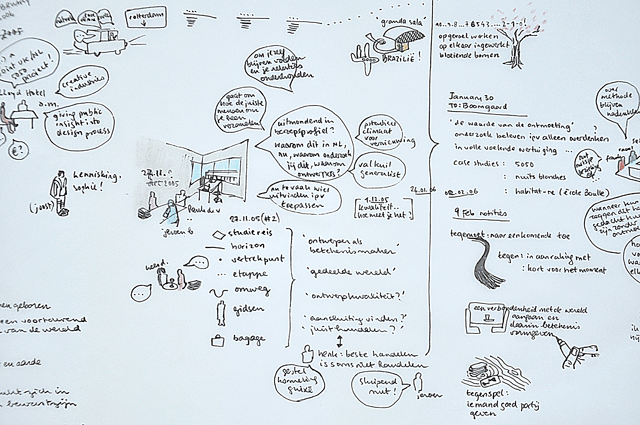Note: Welcoming the Other
November 2005.
The Professorship of Art and Public Space of the Rietveld Academie (Amsterdam, NL) led by art historian and art critic Jeroen Boomgaard, has invited me to join them. It’s is a great opportunity to conduct fundamental research (i.e. not commission or project driven) alongside fellow artists, designers and teachers, and to get critical feedback from peers in the process.
My plan is to research the dynamics of collaboration processes. I am writing about the designer as a maker of meaning (“een betekenismaker”), and the quality of encounters. I just finished reading “Met Open Zinnen” (With Open Senses) by philosopher Ton Lemaire. He made me realise, among others, that “connaître”, to know, comes from “co-naître”, to be born together. The Other thus enables us to grow beyond ourself. At designLAB, the bachelor course I began run this fall at the Rietveld Academie, students are working on a brief entitled ‘In search of the Other’, inspired by artist Bas Jan Ader, whose career ended and whose legend started when he disappeared at sea. At the same time, I am reading about working in solitude, and the richness of encounters that this solitude engenders: “Quand on travaille on est forcément dans une solitude absolue. (…) C’est du fond de cette solitude qu’on peux faire n’importe quelle rencontre.”*
Critical feedback from my fellow researchers on my first proposal abounds:
– What kind of cooperation are you concerned with?
– What do you hope to achieve with this research, and why?
– Why is your research important today?
– Think about your method, means and goal tend to contaminate one another
– Step back: what is the basis of your research, what does a dialogue signify?
– What is the space of the other in a design process? What makes the other necessary?
– You don’t seem to give space to the other to appear; define your position better
Tentative new research question:
HOW TO MAKE ROOM FOR, AND WELCOME, THE OTHER IN ONE’S PROCESS?
* Gilles Deleuze in Dialogues, Gille Deleuze & Claire Parnet, Flamarrion, 2004.
